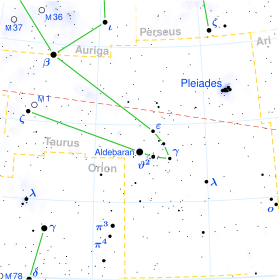Tau Tauri
Tau Tauri, Latinized from τ Tauri, is a quadruple star system[5] in the constellation Taurus. It is visible to the naked eye as a faint point of light with a combined apparent visual magnitude of 4.33.[14] The distance to this system is approximately about 400 light years based on parallax.[1] The system is moving further from the Earth with a heliocentric radial velocity of +14.6 km/s,[7] and it is a member of the Taurion OB association, located between Orion and Taurus.[15] It is located 0.7 degree north of the ecliptic, and thus is subject to lunar occultations.[4]
| Observation data Epoch J2000 Equinox J2000 | |
|---|---|
| Constellation | Taurus |
| Right ascension | 04h 42m 14.70161s[1] |
| Declination | 22° 57′ 24.9214″[1] |
| Apparent magnitude (V) | 4.27[2] |
| Characteristics | |
| Spectral type | B3V[3] + ? + A0V–A2V[4] + A1V[5] |
| U−B color index | -0.57[6] |
| B−V color index | -0.14[6] |
| Astrometry | |
| Radial velocity (Rv) | +14.60[7] km/s |
| Proper motion (μ) | RA: -2.89[1] mas/yr Dec.: -21.86[1] mas/yr |
| Parallax (π) | 8.19 ± 0.88[1] mas |
| Distance | approx. 400 ly (approx. 120 pc) |
| Absolute magnitude (MV) | -1.15[2] |
| Orbit[8] | |
| Primary | Aa |
| Period (P) | 2.956549±0.000002 d |
| Semi-major axis (a) | ≤ 0.01455 AU |
| Eccentricity (e) | 0.051±0.019 |
| Periastron epoch (T) | 2,436,424.207±0.009 JD |
| Argument of periastron (ω) (secondary) | 126.7±21.8° |
| Semi-amplitude (K1) (primary) | 53.6±1.0 km/s |
| Details | |
| Aa | |
| Mass | 6.4[9] M☉ |
| Luminosity | 1,472[10] L☉ |
| Surface gravity (log g) | 2.60[11] cgs |
| Temperature | 18,700[10] K |
| Metallicity [Fe/H] | -0.51[11] dex |
| Rotational velocity (v sin i) | 115[12] km/s |
| Other designations | |
| Database references | |
| SIMBAD | data |
The blue-white hued primary, component Aa, is a B-type main-sequence star with a stellar classification of B3V.[3] It was found to be a close spectroscopic binary in 1903 by American astronomers Edwin B. Frost and Walter S. Adams. The pair have an orbital period of 2.96 days and eccentricity of 0.05.[8] A second companion, white-hued component Ab, has magnitude 6.97 and angular separation 0.2" from the primary in a 58-year orbit.[16][5] This is a probably A-type main-sequence star with a class of A0V–A2V.[4] The more distant component B is a type A1V star with magnitude 7.2 and separation 62.8".[5]
References
- Van Leeuwen, F. (2007). "Validation of the new Hipparcos reduction". Astronomy and Astrophysics. 474 (2): 653. arXiv:0708.1752. Bibcode:2007A&A...474..653V. doi:10.1051/0004-6361:20078357. Vizier catalog entry
- Anderson, E.; Francis, Ch. (2012). "XHIP: An extended hipparcos compilation". Astronomy Letters. 38 (5): 331. arXiv:1108.4971. Bibcode:2012AstL...38..331A. doi:10.1134/S1063773712050015. Vizier catalog entry
- Hoffleit, D.; Warren, W. H. (1995). "VizieR Online Data Catalog: Bright Star Catalogue, 5th Revised Ed. (Hoffleit+, 1991)". VizieR On-line Data Catalog: V/50. Originally Published in: 1964BS....C......0H. 5050. Bibcode:1995yCat.5050....0H.
- Richichi, A.; et al. (June 1994). "New binary stars discovered by lunar occultations". Astronomy and Astrophysics. 286: 829–837. Bibcode:1994A&A...286..829R.
- Eggleton, P. P.; Tokovinin, A. A. (2008). "A catalogue of multiplicity among bright stellar systems". Monthly Notices of the Royal Astronomical Society. 389 (2): 869. arXiv:0806.2878. Bibcode:2008MNRAS.389..869E. doi:10.1111/j.1365-2966.2008.13596.x. Vizier catalog entry
- Mallama, A. (2014). "Sloan Magnitudes for the Brightest Stars". The Journal of the American Association of Variable Star Observers. 42: 443. Bibcode:2014JAVSO..42..443M.Vizier catalog entry
- Wilson, R. E. (1953). General Catalogue of Stellar Radial Velocities. Carnegie Institution for Science. Bibcode:1953GCRV..C......0W. LCCN 54001336.
- Petrie, R. M.; Ebbighausen, E. G. (1961). "The spectroscopic binary Boss 1107". Publications of the Dominion Astrophysical Observatory Victoria. 11: 385–394. Bibcode:1961PDAO...11..385P.
- Tetzlaff, N.; Neuhäuser, R.; Hohle, M. M. (2011). "A catalogue of young runaway Hipparcos stars within 3 kpc from the Sun". Monthly Notices of the Royal Astronomical Society. 410: 190. arXiv:1007.4883. Bibcode:2011MNRAS.410..190T. doi:10.1111/j.1365-2966.2010.17434.x. Vizier catalog entry
- Hohle, M.M.; Neuhäuser, R.; Schutz, B.F. (2010). "Masses and luminosities of O- and B-type stars and red supergiants". Astronomische Nachrichten. 331 (4): 349. arXiv:1003.2335. Bibcode:2010AN....331..349H. doi:10.1002/asna.200911355. Vizier catalog entry
- Wu, Yue; Singh, H. P.; Prugniel, P.; Gupta, R.; Koleva, M. (2010). "Coudé-feed stellar spectral library – atmospheric parameters". Astronomy & Astrophysics. 525: A71. arXiv:1009.1491. Bibcode:2011A&A...525A..71W. doi:10.1051/0004-6361/201015014.
- Abt, Helmut A.; Levato, Hugo; Grosso, Monica (2002). "Rotational Velocities of B Stars". The Astrophysical Journal. 573: 359. Bibcode:2002ApJ...573..359A. doi:10.1086/340590.
- "tau Tau". SIMBAD. Centre de données astronomiques de Strasbourg. Retrieved 2016-10-18.
- Mason, Brian D.; Wycoff, Gary L.; Hartkopf, William I.; Douglass, Geoffrey G.; Worley, Charles E. (2001). "The 2001 US Naval Observatory Double Star CD-ROM. I. The Washington Double Star Catalog". The Astronomical Journal. 122 (6): 3466. Bibcode:2001AJ....122.3466M. doi:10.1086/323920. Vizier catalog entry
- Bouy, H.; Alves, J. (December 2015). "Cosmography of OB stars in the solar neighbourhood". Astronomy & Astrophysics. 584: 13. Bibcode:2015A&A...584A..26B. doi:10.1051/0004-6361/201527058. A26.
- Malkov, O. Yu.; Tamazian, V. S.; Docobo, J. A.; Chulkov, D. A. (2012). "Dynamical masses of a selected sample of orbital binaries". Astronomy & Astrophysics. 546: A69. Bibcode:2012A&A...546A..69M. doi:10.1051/0004-6361/201219774. Vizier catalog entry
